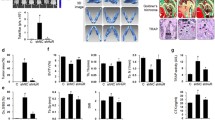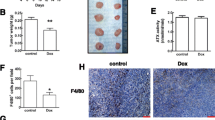Abstract
Purpose
To identify the characteristics and function of a cadherin-like molecule, cloned from a human dendritic cell (DC) cDNA library and designated DC-derived cadherin-like molecule (DC-CLM).
Methods
The mRNA expression of DC-CLM in tissues and cells was analyzed by Northern blot and RT-PCR, respectively. In order to express DC-CLM in target cells, we constructed a pcDNA3.1/DC-CLM expression vector and transfected it into MCF-7 human breast cancer cells. Tumor growth was demonstrated by cell proliferation and colony formation.
Results
DC-CLM cDNA encoded a protein of 260 amino acids and the gene was localized to chromosome 5q31. The predicted protein possessed a definitive cadherin-specific sequence motif and shared homology with classical cadherin. However, no transmembrane segment was observed in DC-CLM. Northern blot revealed the ubiquitous nature of DC-CLM transcripts in human tissues, with high expression in heart, brain, prostate, testis and ovary. RT-PCR demonstrated that DC-CLM was widely expressed in hematopoietic and epithelial tumor cell lines, but was not expressed in MCF-7. Interestingly, DC-CLM expression was upregulated in DC activated by lipopolysaccharides. DC-CLM expression in the stable transfectant (MCF-7/DC-CLM) was confirmed by RT-PCR and Western blot. DC-CLM protein was found to be secreted by MCF-7/DC-CLM but not expressed on the membrane of MCF-7/DC-CLM. DC-CLM transfection resulted in significant inhibition of in vitro growth and colony formation of MCF-7 cells.
Conclusions
A cadherin-like molecule DC-CLM was cloned from human DC and it may be a soluble cadherin-like molecule for tumor suppression. DC-CLM was upregulated in activated DC and may be involved in the effector function of activated DC.







Similar content being viewed by others
References
Angst BD, Marcozzi C, Magee AI (2001a) The cadherin superfamily. J Cell Sci 114:625–626
Angst BD, Marcozzi C, Magee AI (2001b) The cadherin superfamily: diversity in form and function. J Cell Sci 114:629–641
Blauvelt A, Katz SI, Udey MC (1995) Human Langerhans cells express E-cadherin. J Invest Dermatol 104:293–296
Borkowski TA, Van Dyke BJ, Schwarzenberger K, McFarland VW, Farr AG, Udey MC (1994) Expression of E-cadherin by murine dendritic cells: E-cadherin as a dendritic cell differentiation antigen characteristic of epidermal Langerhans cells and related cells. Eur J Immunol 24:2767–2774
Bremnes RM, Veve R, Hirsch FR, Franklin WA (2002) The E-cadherin cell-cell adhesion complex and lung cancer invasion, metastasis, and prognosis. Lung Cancer 36:115–124
Cao X, Zhang W, Wan T, He L, Chen T, Yuan Z, Ma S, Yu Y, Chen G (2000) Molecular cloning and characterization of a novel CXC chemokine macrophage inflammatory protein-2 gamma chemoattractant for human neutrophils and dendritic cells. J Immunol 165:2588–2595
Chapoval AI, Tamada K, Chen L (2000) In vitro growth inhibition of a broad spectrum of tumor cell lines by activated human dendritic cells. Blood 95:2346–2351
Conacci-Sorrell M, Zhurinsky J, Ben Ze'ev A (2002) The cadherin-catenin adhesion system in signaling and cancer. J Clin Invest 109:987–991
Jiang WG, Singhrao SK, Hiscox S, Hallett MB, Bryce RP, Horrobin DF, Puntis MC, Mansel RE (1997) Regulation of desmosomal cell adhesion in human tumour cells by polyunsaturated fatty acids. Clin Exp Metastasis 15:593–602
Kogai T, Schultz JJ, Johnson LS, Huang M, Brent GA (2000) Retinoic acid induces sodium/iodide symporter gene expression and radioiodide uptake in the MCF-7 breast cancer cell line. Proc Natl Acad Sci U S A 97:8519–8524
Lee SW (1996) H-cadherin, a novel cadherin with growth inhibitory functions and diminished expression in human breast cancer. Nat Med 2:776–782
Lee SW, Reimer CL, Campbell DB, Cheresh P, Duda RB, Kocher O (1998) H-cadherin expression inhibits in vitro invasiveness and tumor formation in vivo. Carcinogenesis 19:1157–1159
Liu S, Yu Y, Zhang M, Wang W, Cao X (2001) The involvement of TNF-alpha-related apoptosis-inducing ligand in the enhanced cytotoxicity of IFN-beta-stimulated human dendritic cells to tumor cells. J Immunol 166:5407–5415
Lu L, Bonham CA, Chambers FG, Watkins SC, Hoffman RA, Simmons RL, Thomson AW (1996) Induction of nitric oxide synthase in mouse dendritic cells by IFN-gamma, endotoxin, and interaction with allogeneic T cells: nitric oxide production is associated with dendritic cell apoptosis. J Immunol 157:3577–3586
Lu L, Qian S, Hershberger PA, Rudert WA, Lynch DH, Thomson AW (1997) Fas ligand (CD95L) and B7 expression on dendritic cells provide counter-regulatory signals for T cell survival and proliferation. J Immunol 158:5676–5684
Moll R, Mitze M, Frixen UH, Birchmeier W (1993) Differential loss of E-cadherin expression in infiltrating ductal and lobular breast carcinomas. Am J Pathol 143:1731–1742
Mueller S, Cadenas E, Schonthal AH (2000) p21WAF1 regulates anchorage-independent growth of HCT116 colon carcinoma cells via E-cadherin expression. Cancer Res 60:156–163
Nagar B, Overduin M, Ikura M, Rini JM (1996) Structural basis of calcium-induced E-cadherin rigidification and dimerization. Nature 380:360–364
Nieman MT, Prudoff RS, Johnson KR, Wheelock MJ (1999) N-cadherin promotes motility in human breast cancer cells regardless of their E-cadherin expression. J Cell Biol 147:631–644
Okazaki N, Takahashi N, Kojima S, Masuho Y, Koga H (2002) Protocadherin LKC, a new candidate for a tumor suppressor of colon and liver cancers, its association with contact inhibition of cell proliferation. Carcinogenesis 23:1139–1148
Padovan E, Terracciano L, Certa U, Jacobs B, Reschner A, Bolli M, Spagnoli GC, Borden EC, Heberer M (2002) Interferon stimulated gene 15 constitutively produced by melanoma cells induces E-cadherin expression on human dendritic cells. Cancer Res 62:3453–3458
Peng YF, Mandai K, Nakanishi H, Ikeda W, Asada M, Momose Y, Shibamoto S, Yanagihara K, Shiozaki H, Monden M, Takeichi M, Takai Y (2002) Restoration of E-cadherin-based cell-cell adhesion by overexpression of nectin in HSC-39 cells, a human signet ring cell gastric cancer cell line. Oncogene 21:4108–4119
Perez EA, Buckwalter CA (1998) Sequence-dependent cytotoxicity of etoposide and paclitaxel in human breast and lung cancer cell lines. Cancer Chemother Pharmacol 41:448–452
Pishvaian MJ, Feltes CM, Thompson P, Bussemakers MJ, Schalken JA, Byers SW (1999) Cadherin-11 is expressed in invasive breast cancer cell lines. Cancer Res 59:947–952
Ranscht B, Dours-Zimmermann MT (1991) T-cadherin, a novel cadherin cell adhesion molecule in the nervous system lacks the conserved cytoplasmic region. Neuron 7:391–402
Riedl E, Stockl J, Majdic O, Scheinecker C, Knapp W, Strobl H (2000) Ligation of E-cadherin on in vitro-generated immature Langerhans-type dendritic cells inhibits their maturation. Blood 96:4276–4284
Ryniers F, Stove C, Goethals M, Brackenier L, Noe V, Bracke M, Vandekerckhove J, Mareel M, Bruynzeel E (2002) Plasmin produces an E-cadherin fragment that stimulates cancer cell invasion. Biol Chem 383:159–165
Salahshor S, Hou H, Diep CB, Loukola A, Zhang H, Liu T, Chen J, Iselius L, Rubio C, Lothe RA, Aaltonen L, Sun XF, Lindmark G, Lindblom A (2001) A germline E-cadherin mutation in a family with gastric and colon cancer. Int J Mol Med 8:439–443
Sato M, Mori Y, Sakurada A, Fujimura S, Horii A (1998) The H-cadherin (CDH13) gene is inactivated in human lung cancer. Hum Genet 103:96–101
Takeichi M (1993) Cadherins in cancer: implications for invasion and metastasis. Curr Opin Cell Biol 5:806–811
Takeuchi T, Liang SB, Matsuyoshi N, Zhou S, Miyachi Y, Sonobe H, Ohtsuki Y (2002) Loss of T-cadherin (CDH13, H-cadherin) expression in cutaneous squamous cell carcinoma. Lab Invest 82:1023–1029
Trusolino L, Rabino M, Prat M, Cremona O, Savoia P, Marchisio PC (1993) A novel GPI-anchored glycoprotein shows properties of a COOH-terminus truncated cadherin involved in cell-cell contacts of cultured human epithelial cells. Cytotechnology 11 [Suppl 1]:S97–S99
van de Wetering M, Barker N, Harkes IC, van der Heyden M, Dijk NJ, Hollestelle A, Klijn JG, Clevers H, Schutte M (2001) Mutant E-cadherin breast cancer cells do not display constitutive Wnt signaling. Cancer Res 61:278–284
Verhasselt V, Buelens C, Willems F, De Groote D, Haeffner-Cavaillon N, Goldman M (1997) Bacterial lipopolysaccharide stimulates the production of cytokines and the expression of costimulatory molecules by human peripheral blood dendritic cells: evidence for a soluble CD14-dependent pathway. J Immunol 158:2919–2925
Waki T, Tamura G, Tsuchiya T, Sato K, Nishizuka S, Motoyama T (2002) Promoter methylation status of E-cadherin, hMLH1, and p16 genes in nonneoplastic gastric epithelia. Am J Pathol 161:399–403
Wu Q, Maniatis T (1999) A striking organization of a large family of human neural cadherin-like cell adhesion genes. Cell 97:779–790
Wyder L, Vitaliti A, Schneider H, Hebbard LW, Moritz DR, Wittmer M, Ajmo M, Klemenz R (2000) Increased expression of H/T-cadherin in tumor-penetrating blood vessels. Cancer Res 60:4682–4688
Zhang W, Wang J, Wang Q, Chen G, Zhang J, Chen T, Wan T, Zhang Y, Cao X (2001) Identification of a novel type I cytokine receptor CRL2 preferentially expressed by human dendritic cells and activated monocytes. Biochem Biophys Res Commun 281:878–883
Acknowledgements
We sincerely thank Mrs. Mei Jin and Mrs. Qunying Shi for their excellent technical assistance.
Author information
Authors and Affiliations
Corresponding author
Additional information
This work was supported by grants from the National Natural Science Foundation (30100166, 30121002) and the National Key Basic Research Program of China (2001CB510002)
Y.J. and T.W. contributed equally to this work.
Rights and permissions
About this article
Cite this article
Jiang, Y., Wan, T., Chen, G. et al. DC-CLM, a cadherin-like molecule cloned from human dendritic cells, inhibits growth of breast cancer cells. J Cancer Res Clin Oncol 129, 57–64 (2003). https://doi.org/10.1007/s00432-002-0404-8
Received:
Accepted:
Published:
Issue Date:
DOI: https://doi.org/10.1007/s00432-002-0404-8




